|
Castle Clinton's location at the tip of Manhattan doesn't exclude the area from having wildlife. There are a few species of birds and mammals that thrive in a city environment. 
NPS Photo/Christine Cieslak Mammals Eastern Grey squirrel Sciurus carolinensis
The Eastern gray squirrels of Castle Clinton are a popular tourist attraction. These squirrels are active throughout the year and do not hibernate. Identification The Eastern gray squirrel is mostly covered in gray fur but they can have a reddish hue. Its underside is white and it flourishes a large bushy tail. Individuals can also be white, brown, or black. They can grow to be 9-12 inches in length. Distribution The Eastern Gray Squirrel’s native range includes the eastern and midwestern United States and nearby parts of Canada. It thrives in dense woodlands as well as urban ecosystems where the risk of predation is reduced. Feeding and Nesting Behavior Eastern gray squirrels often forage for nuts and seeds oftentimes burying these in the ground and helping with seed dispersal. In the city, they will also scavenge on food left behind by humans. Some squirrels may raid birds' nests for eggs. These squirrels will often use trees for nests, especially holes which provide shelter for their young. They may also create dreys which are nests built in trees as large clumps of branches, leaves, and moss where they can retreat. In the city, they may find nesting sites in buildings as well. Threats In New York City the Grey Squirrel does not face too many threats, occasionally the local raptors will hunt them. 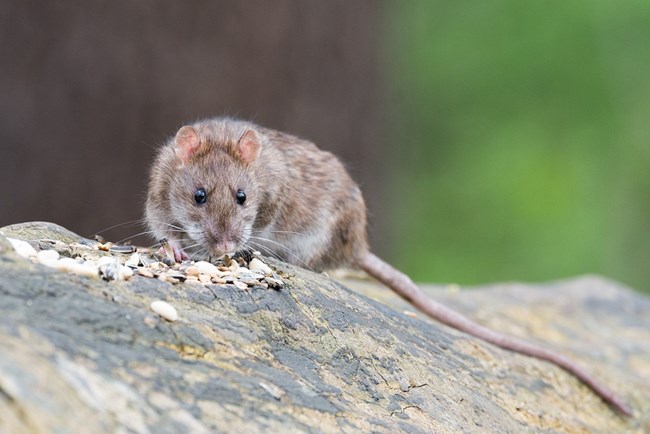
Pixabay Brown rat or Norway rat Rattus norvegicus
Infamous in the streets of New York City, Brown rats are generally active at night, so it is unlikely you will see them during your visit to Castle Clinton. One of its other names “Norway rat” is misleading as these rats did not originate in Norway. Identification One of the largest of like rodents, the Brown rat is usually brown or gray with a lighter underside. It can have a body between 5.9-11 inches long, with a slightly shorter tail length. Distribution It is believed that this species is native to Northern China, but it has spread across all continents. Evidence dates it back as far as colonial times in New York City. Feeding and Nesting Behavior Brown rats are omnivores eating anything from seeds, to plants, and meat and their diets depend heavily on their environment. In urban areas, like New York City, they will eat almost any discarded food left by humans. Brown rats will often burrow underground or within a similar sheltered habitat where they will nest. This can be in gardens, homes, or the sewer system. They will fill the nest with various materials to keep them warm and comfortable. Threats Threats to the Brown rat in the city include traffic accidents and rodent control, such as rodenticides. 
NPS Photo/Christine Cieslak Birds Red-tailed Hawk Buteo jamaicensis
The most common hawk in North America, the Red-tailed Hawk can be seen perched high in the trees or soaring around Battery Park; they are often visible at their perch from the parade grounds at Castle Clinton. Identification A large raptor, the Red-tailed Hawk is mostly brown on top and has a defining red tail. Its undersides are pale and a dark band can be seen across its chest and along the ends of its flight feathers while in flight. As raptors, they have characteristic meat-eating beaks that form a sharp downward hook for ripping apart meat and large talons that they use to grasp prey. Distribution Red-tailed Hawks can be found throughout most of North America, breeding anywhere from western Alaska and Canada to as far south as Panama. Many move south from the most northern ranges in the winter, while others never migrate. They occupy various habitats and do well in the city where the buildings mimic tall cliffs and where there is an abundance of prey such as pigeons and rats. Feeding and Nesting Behavior Red-tailed Hawks feed mainly on mammals, but will also eat other birds, or reptiles. They will sit atop tall posts or in trees waiting for prey to swoop down upon. They may also hunt while soaring over fields or parks. Red-tailed hawks create platform nests, which are large, flat piles of sticks with a small indent where they will lay their eggs. They build their nests in the tops of trees, on cliffs, or on manmade structures such as buildings and tall fixtures. Threats Red-tailed Hawks have a stable and growing population, giving them a conservation status of least concern. In urban areas, they are faced by threats involving human interference, including road collisions and the ingestion of toxic rodenticides when preying upon infected populations. 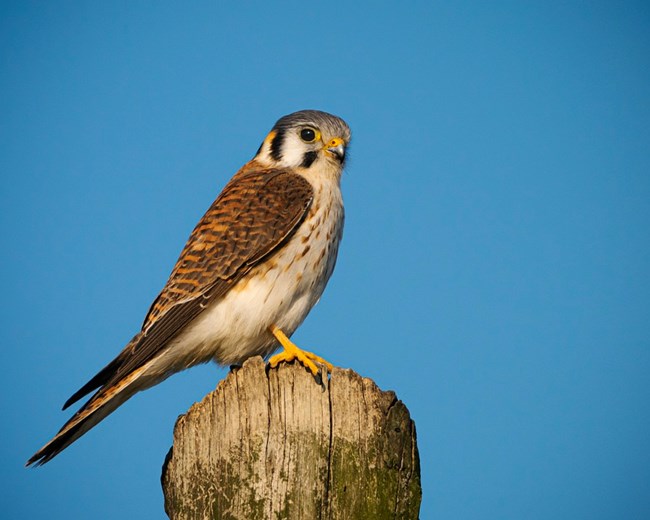
Pixabay American Kestrel Falco sparverius
One of the smallest North American raptors, the American Kestrels' striking coloration and bold nature is a special sight. They can be seen in Battery Park chasing off the Red-tailed hawk or perched high up on a tree or post searching for prey. Identification A small falcon, the American Kestrel characteristically has a long-tail and two dark stripes on its face, but the male and female differ greatly in coloration. The male kestrel has bright blue-gray feathers on the head and wings, with a rust color on its back, and dark marks across its body. The female has the same rusty red-brown coloring with black barring and a gray crown, but lacks the bright blue-gray color. Distribution The American Kestrel’s range spans across most of the Americas with some populations migrating from its more northern ranges. They can be found in grasslands and meadows as well as in more developed areas where they favor pastures and urban parks. Feeding and Nesting Behavior American Kestrels feed mainly on large insects but may also eat small mammals, birds, or reptiles. They will sit upon tall perches searching for prey or may forage directly in flight. They also exhibit hovering behavior, the ability to fly in one place, which not all birds can do. This species nests in cavities, or where there is a hollow they can fit in to raise their young. These cavity nests may be old woodpecker holes, natural tree crevices, or small hideaways in buildings. Threats While American Kestrels have a conservation status of least concern, populations have been in decline, especially in the northeast. The reasons for the decline are not fully understood. Nest boxes are being put out to help the species with nesting site availability. 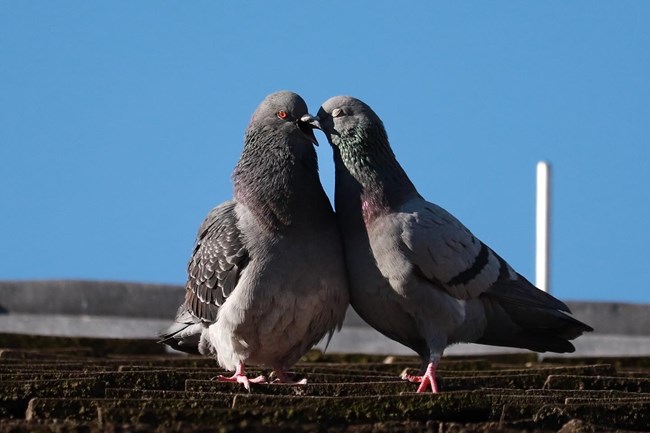
NPS Photo/Christine Cieslak Rock Pigeon or Rock Dove Columba livia Rock Pigeons, or simply pigeons, are familiar birds to New Yorkers, found across the city along streets and roofs and around parks and squares. They are very social birds that often flock together where they can find food and safety. At Castle Clinton, you will find them perched along the walls, walking on the parade grounds, or tucked away in the casemates. Rock Pigeons were introduced to North America from Europe in the early 1600’s. In their native range, wild populations inhabit cliffsides and eat seeds and berries. Feral populations have adapted well to the cityscape where tall structures mimic the rocky heights and food is readily available. Identification These fairly sizable birds are most commonly described as blue bar, with mostly pale blue-gray feathers across their bodies, green and purple iridescence on their necks, and two dark bands along their wings. Although, this is just one of their many color morphs, as variations in plumage include solid, checkered, and splotchy patterns of black, white, blue-gray, pale pink, and rusty red colors. Distribution Pigeons inhabit urban cityscapes and residential areas. You can find them lined along window sills, under bridges, or throughout local parks. Their range extends across the globe and almost fully within the Americas except in northernmost locations where the climate is unfavorable for them. Feeding and Nesting Behavior Pigeons have very generalist feeding habits and naturally their diet consists of seeds, fruits, and sometimes even small insects. While they often forage on food scraps from the trash or leftover bread that is thrown to them, these are not sustainable or nutritious options and can actually cause them damage. Pigeons mate for life and create nests of assorted twigs, straw, and trash in an unorganized fashion. They keep their nests hidden from predators in elevated locations such as under bridges, on rooftops, or along the ledges of buildings. Pigeons have a conservation status of least concern. In the city, their biggest threat may be the local raptors that predate them. 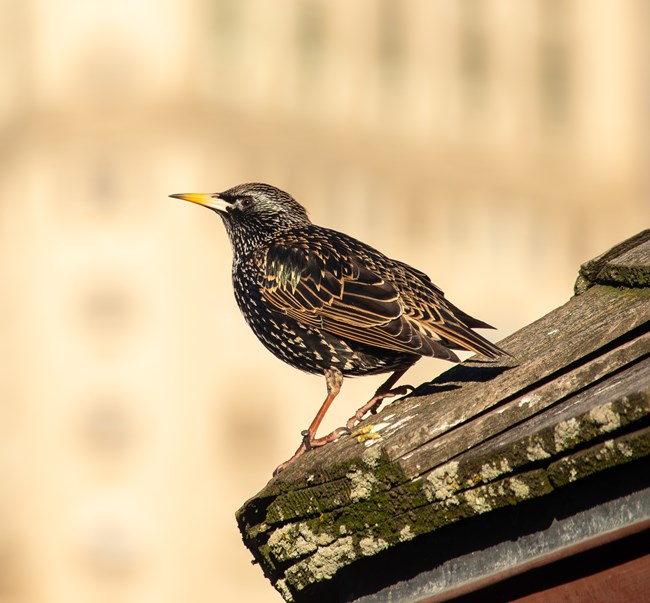
NPS Photo/Christine Cieslak European Starling Sturnus vulgaris European Starlings are very common in urban areas. Considered an invasive species, these birds are rumored to have been introduced into Central Park by Shakspeare enthusiasts in 1890. During the breeding season, they compete with native birds and will often take over suitable nest sites. They are also great vocal mimics, listen for their high metallic calls and chirps around the Castle especially in the mornings or around closing time. Identification European Starlings are medium-sized stocky birds, with finely pointed yellow bills. In breeding plumage, they are dark and glossy with green and purple iridescence. White spots can be seen on their bodies throughout fall and winter. Distribution In North America, European Starlings have spread from Alaska to Mexico, where there are over 200 million individuals. They are found primarily around cities and towns, zigzagging on park lawns or fields where they forage. Their native range includes Europe, Southwest Asia, and Northern Africa. Feeding and Nesting Behavior European Starlings can eat a variety of things, but they prefer insects, which they forage for in grassy fields. European Starlings are cavity nesters, meaning they will build their nest within holes. These hollow nests can be found in trees, streetlights, or hidden away in buildings. Threats European Starlings have a conservation status of least concern. While they are highly adaptable in their nonnative range, like most birds they face the inherent challenges of climate change including heat waves which can affect young nesting birds. 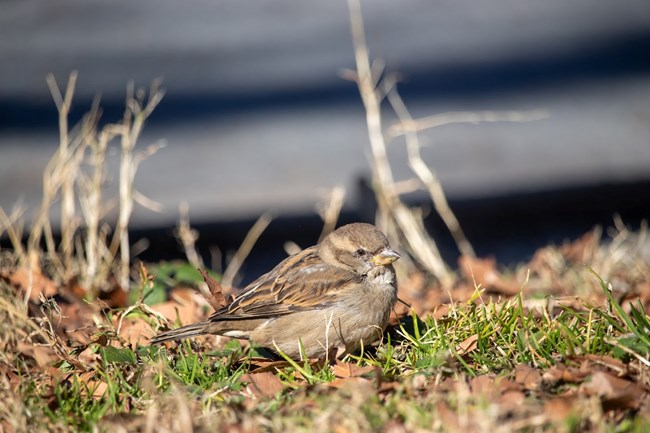
NPS Photo/Christine Cieslak House Sparrow Passer domesticus As their name suggests, House Sparrows can be found in company with humans near houses and buildings. They are another of our common city birds that frequent the area around Castle Clinton. Look for them hopping around on the ground near the entrance or out by the food carts in Battery Park. Identification Distribution House Sparrows are distributed worldwide, but their natural range lies in Europe, parts of Asia, and North Africa. In North America they are an invasive species, often competing with native birds for nesting sites. They can be found within the built environment where there are manmade structures such as buildings, sidewalks, and urban parks. Feeding and Nesting Behavior House Sparrows primarily feed on seeds and grains. In the city, they will also eat food scraps, but these are not as nutritious and may cause them damage. In the summer, they can be seen foraging for insects, which they feed to their chicks. House Sparrows are cavity nesters, meaning they prefer to nest in small holes. In the city, these can be found in buildings, streetlights, and under overhanging fixtures. They tend not to nest in the cavities of trees as often. Threats House Sparrows have a conservation status of least concern. Although, like most birds they face the inherent challenges of climate change including heat waves which can affect young nesting birds.

NPS Photo/Christine Cieslak Ring-billed Gull Larus delawarensis Ring-billed Gulls are common species to see near the harbor, but don’t let the colloquial term “seagull" mislead you, gulls can often be found away from the shoreline. These gulls have adapted to live alongside humans and often frequent parking lots, beaches, and dumpsites. Keep an eye out for them flying overhead or on top of the walls at Castle Clinton. Identification A medium-sized gull that as an adult has a pale gray back, white chest, yellow legs, black tail, and pale eyes. It is named for its yellow bill that has a black-ring around it. Distribution Ring-billed gulls can be found across a large portion of North America over their migration range. They can be found in New York City all year round around the water, but they are not restricted to coastlines as they often will fly further inland. Feeding and Nesting Behavior Ring-billed Gulls are diligent foragers and have a varied diet consisting of fish, insects, rodents, and food scraps. They are also notorious for stealing food from other birds. This species nests alongside bodies of freshwater (such as lakes) in large colonies. Their nests are usually scrapes, or indentations, in the ground that they line with twigs and vegetation. Threats The Ring-billed Gull has a conservation status of least concern. Overall their populations appear to be increasing, it is speculated that this could lead to competition with other birds that nest in similar habitats. |
Last updated: February 22, 2024
